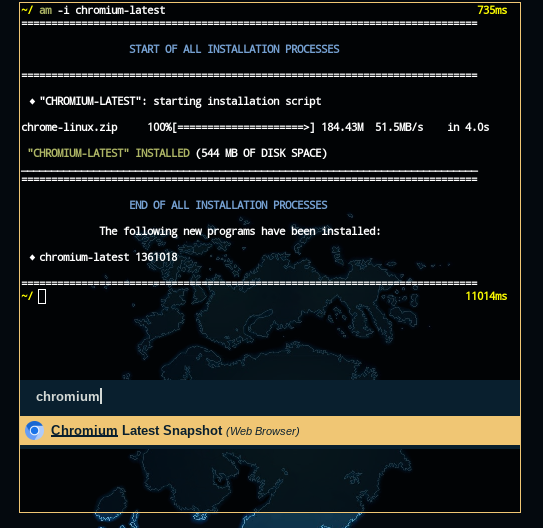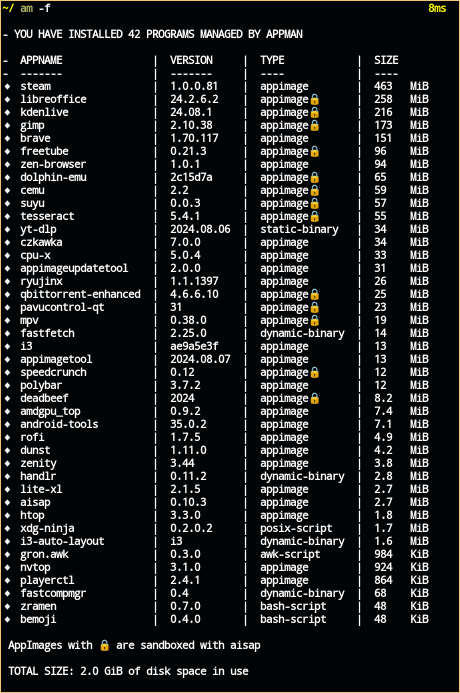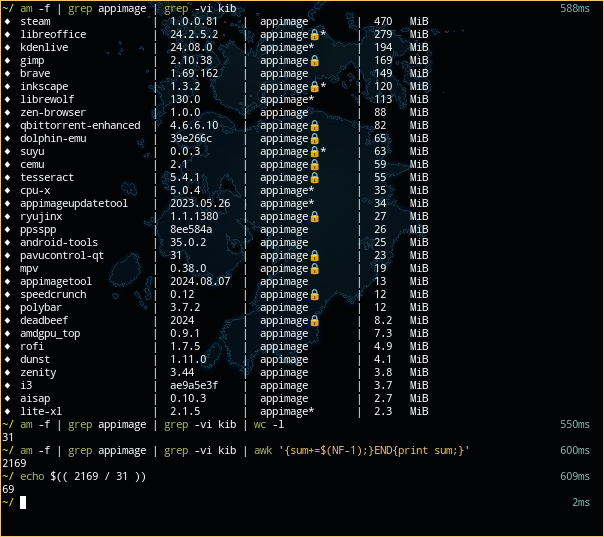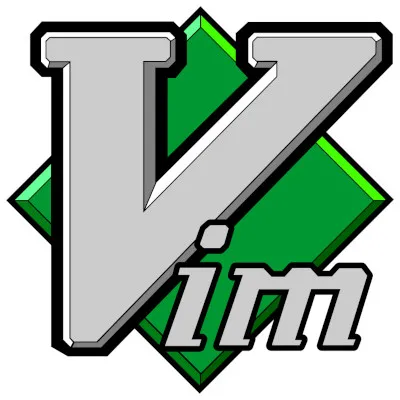 Samueru
7d ago
•
100%
Samueru
7d ago
•
100%
You can use appimages, more importantly if you make a directory next to the appimage with the name of the appimage + .home the appimage will also set that as its $HOME that way you can also keep the configuration files of the app separated from the host OS.
You can also sandbox appimages with aisap.
 Samueru
3w ago
•
100%
Samueru
3w ago
•
100%

It pulls the latest chromium from googleapis.com so it can do everything.
 Samueru
3w ago
•
100%
Samueru
3w ago
•
100%
This is already done automatically.
AM puts the .desktop files in /usr/local/share/applications
AppMan puts them in ${XDG_DATA_HOME:-~/.local/share}applications
They also get symlinked in PATH, that is you can launch yt-dlp by typing yt-dlp on the terminal as if you had installed it with your distro package manager.
 Samueru
4w ago
•
100%
Samueru
4w ago
•
100%
I wonder, is there a tool that lets me script installs?
I’ll want to check if application exists, and if so, update, otherwise, install. That kind of thing.
Use AppMan to install them in HOME.
 Samueru
4w ago
•
100%
Samueru
4w ago
•
100%
Check this out: https://github.com/ivan-hc/AM
Use appman and set the install directory to ~/Apps and now you will be able to install appimages/binaries in the ~/Apps dir using a package manager that keeps them up to date and that you can move to any other distro, I have all of this:

Although more recently for binaries I've been using this instead, which pulls from a massive repo of static binaries, though note that dbin needs its own separate directory in HOME to install binaries (you can't use ~/Apps that is).

 Samueru
1mo ago
•
100%
Samueru
1mo ago
•
100%
I’m curious, what makes AppImage a good choice for the lazy developer? Is it easier to create?
The appimage is basically just git clone -> make -> make install DESTDIR=/path/to/AppDir -> wget appimagecreationtool and finally appimagecreationtool /path/to/AppDir and that's it you have your appimage.
appimagecreationtool being several tools that can create the appimage from an AppDir, like linuxdeploy, linuxdeploqt, go-appimage, etc
And that on itself isn't complex either, it if basically running ldd on the binary, then copy those libraries into the AppDir and finally run patchelf to patch the paths in the binaries and libraries, suyu uses a deploy script instead of using those tools, which I've recently forked and began expanding.
I don't know how easy it is to make a flatpak or snap, but I do know the dev of zen browser hates dealing with the flatpak and iirc right now the flatpak is outdated as result.
EDIT: Also lite-xl has been making a flatpak for like 2 years and it isn't ready yet.
 Samueru
1mo ago
•
100%
Samueru
1mo ago
•
100%
. If you end up with 4.7GB for runtimes, that’s basically nothing these days
Yes but that wasn't the original comment I replied to was about.
163 flatpaks and the runtimes used 8.7GB
163 flatpaks using 8.7 GiB means that the average flatpak is using 54.6 MiB.
That's good the other time I got this linked: https://tesk.page/2023/06/04/response-to-developers-are-lazy-thus-flatpak/#but-flatpaks-are-easier-for-end-users
Which is no good as in that example there was 173 flatpaks using 27.66 GiB, average 160 MiB, while in your case the average flatpak is using 91 MiB.
This is what I have with appimages:

In this case the average appimage is using 69 MiB, though there is one outliner which is the Steam appimage that I have there (470 MiB) which is an entire conty container with its own video drivers and everything, without it the average would be 56 MiB.
I know this doesn't matter these days but once again that wasn't what the original comment was about.
Well we are talking about two gigs, after all. Unless you’re using an embedded system, it’s not a much of a concern if you ask me. But it is more, true
Thanks for the link showing an average flatpak using 54 MiB though, didn't think it was possible lol.
WAIT I just took a deeper look at the link, isn't that guy just showing the runtimes without the applications using 8.7 GiB?
 Samueru
1mo ago
•
100%
Samueru
1mo ago
•
100%
I tested installing some web browers, kdenlive, yuzu and libreoffice and without knowing I ended up with 3 different runtimes and the total storage usage (with deduplication) was 4.79 GIB.
Meanwhile with 33 appimages that I have (which includes same flatpak apps I mentioned) are using 2.2 GiB.
It doesn't matter if they share if in the end they end up using several times more storage than the appimage equivalent.
 Samueru
1mo ago
•
100%
Samueru
1mo ago
•
100%
Isn't the gnome runtime alone 2GiB? You know how many appimages that is?
Not to mention you are unlikely to only use one runtime.
 Samueru
1mo ago
•
100%
Samueru
1mo ago
•
100%
I'm pretty sure sbin originally meant static binaries and not system binaries lol
 Samueru
2mo ago
•
100%
Samueru
2mo ago
•
100%
it may have the same problem.
It actually doesn't! it works thank you!
Btw when I have multiple tabs on the vomnibar, if I scroll down the list using the arrow keys it doesn't change to the next page, I instead have to use the mouse wheel to move to the next page, is there a way I can fix that?
 Samueru
2mo ago
•
100%
Samueru
2mo ago
•
100%
Is there an easy way to migrate my vimium conf to it?
Also are you sure that it displays the page icon in the active tabs menu?
I know vimium works in firefox, however I ran into this 4 year issue: https://github.com/philc/vimium/issues/3674 Is there an alternative that doesn't have that issue?
 Samueru
2mo ago
•
100%
Samueru
2mo ago
•
100%
posix sh + awk for manipulating data?
 Samueru
2mo ago
•
100%
Samueru
2mo ago
•
100%
It makes me mad to see the current state sway is in, I even bought an AMD GPU for nothing.
 Samueru
2mo ago
•
100%
Samueru
2mo ago
•
100%
Test adding the preferences page to "excluded URLs" in the settings of vimium.
 Samueru
2mo ago
•
100%
Samueru
2mo ago
•
100%
Vimium.
 Samueru
3mo ago
•
100%
Samueru
3mo ago
•
100%
PWA ffs
 Samueru
3mo ago
•
100%
Samueru
3mo ago
•
100%
I really don't know lol
Increasing the max_map_count is needed for some Steam games, iirc Arch is now dong this by default.
iirc the dirty_bytes settings prevent the system from hanging if there is too much disk IO
And setting transparent_hugepages to madvise was something I did when archlinux had this bug in the kernel: https://old.reddit.com/r/archlinux/comments/1atueo0/higher_ram_usage_since_kernel_67_and_the_solution/
It was eventually fixed but I later ran into the issue again and I decided to keep it on madvise.
 Samueru
3mo ago
•
100%
Samueru
3mo ago
•
100%
Here is what I ended up using for my sysctl conf, iirc I got some of these from popos default config:
vm.swappiness = 180
vm.page-cluster = 0
vm.watermark_boost_factor = 0
vm.watermark_scale_factor = 125
vm.dirty_bytes = 268435456
vm.dirty_background_bytes = 134217728
vm.max_map_count = 2147483642
vm.dirtytime_expire_seconds = 1800
vm.transparent_hugepages = madvise
I'm a i3 user that has been trying to migrate to sway. I use it with these environment variables: ``` export XDG_DATA_HOME="$HOME/.local/share" export XDG_STATE_HOME="$HOME/.local/var/state" export XDG_CONFIG_HOME="$HOME/.local/config" export XDG_CACHE_HOME="$HOME/.local/var/cache" ``` Which gives me a clean home with only `~/.local` for my dotfiles. And issue that I've noticed that I haven't been able to fix is that every time that I start sway, hyprland and also the alpha of cosmic is that I get a new `~/.cache` directory created in my home that contains a `mesa_shader_cache` directory. Btw in the middle of writing this post I just ran into another bug, thunar for some reason decided to steal my key presses from the web browser, and even though I had the browser window focused as I have sway configured to change the border color of the window with focus, thunar was like nope wtf. Thank you all for the help, ended up opening a bug report at sway: https://github.com/swaywm/sway/issues/8191
I have this command on my i3wm configuration, which extends the 3 displays that I have into a single one for games. bindsym $mod+Shift+k exec "xrandr --setmonitor extended auto DP-1,DP-2,DP-3" The only issue that I have is, once I'm done, how do I revert back to having the displays individually? This has been driving me crazy. Searching on internet all that I've managed to find is using xrandr -s 0, which actually just turns off my other displays. And what is worse is that if I then manually turn the displays back on, THEY ARE STILL EXTENDED "xrandr -s 0" does not even reset that lol. So far what I have to do to revert the changes is to log out of my current session. SOLUTION: THE COMMAND IS: xrandr --delmonitor extended
Here is the script, which is a hack that I use with i3wm, I already converted most of it to a single line and it still works: #!/usr/bin/env bash is-leaf-node() { i3-msg -t get_tree | jq 'recurse(.nodes[]?, .floating_nodes[]?) | select(.type == "con" or .type == "floating_con") | select(.focused == true) | .nodes == []';}; parent-type() { i3-msg -t get_tree | jq -r 'recurse(.nodes[]?, .floating_nodes[]?) | select(.nodes[]?.focused == true) | .type' ;}; if [ "$(is-leaf-node)" == "true" ]; then i3-msg focus parent, focus parent; else i3-msg focus child, focus child; fi Here is where I'm stuck: The script needs the #!/usr/bin/env bash to work, it is the only script that I have that needs it. Changing it to #!/usr/bin/env bash; <SCRIPT> does not work, it has have a second line for it to work.
I'm trying to migrate from lightdm to just using startx to start my i3 session. First I had issues with kdeconnect working which were fixed by replacing exec i3 with exec dbus-launch --exit-with-session i3 in the xinitrc. Now even though the apps works it is not following the system theme, I checked qt5ct and it is telling me that QT_QPA_PLATFORMTHEME is not set to qt5ct. But I do have export QT_QPA_PLATFORMTHEME=qt5ct on my ~/.profile it seems the file is not being read but I have no idea on how to fix it.

